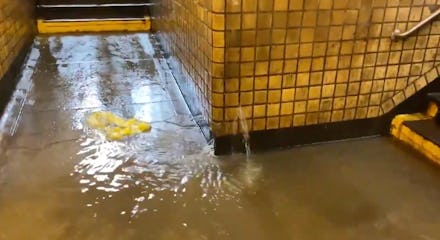On Thursday, heavy rainfall hammered New York City in the lead up to the arrival of Tropical Storm Elsa. The skies opened up and dumped more than 2.25 inches of water on the city in a matter of hours, according to AccuWeather. While New York City is no stranger to storms and extreme weather, much of the Big Apple's infrastructure simply was not built to handle that level of sudden rainfall and flash floods that followed. The water flooded the city's subways, leaving would-be passengers stuck wading through waist-high waters and requiring police to launch rescue missions to pull dozens of people from the growing waves.
As videos of the flooding spread, plenty of people took aim at the city's Metropolitan Transportation Authority (MTA) for falling short in its response to the flooding and for failing to do enough to keep it from happening in the first place.
The thing is, for the most part, everything for the MTA basically did work as it was supposed to. Sarah Feinberg, the interim president of the New York City Transit Authority, which is part of the MTA, said on Twitter that "drains are working remarkably well" and that crew members were responding quickly and efficiently as possible. The MTA has spent years and billions of dollars implementing plans to increase the resiliency of the subway against the threats of climate change, including rising sea levels and "100-year storms."
The problem is that New York City has prepared itself for a world that increasingly does not exist. The idea of the once-a-century storm is not that it only happens once every 100 years, but rather that there is a 1% chance of it happening any given year, and that the intensity of that storm will only be equaled or exceeded once a century on average. Most infrastructure, like New York City's subway system, is built with this standard in mind. It needs to be able to survive those conditions, but it's not planning to be exposed to such conditions all that often.
But increasingly, these events that are supposed to be extreme outliers are turning into the norm. As the planet continues to warm and climate change produces more and more extreme weather events, what once happened "once a century" is starting to happen much more regularly. According to a study published in the journal Nature Communications, 100-year storms and floods are expected to happen every single year in some coastal cities.
When these events happen, in the interconnectivity of our infrastructure — from roads and bridges to public transportation to waste and sewage systems — is pushed to the forefront. Just zoom out from New York City's flooding subways to see this in action. While water flowing into the underground transit system caught people's attention, it only happened because the streets above were unable to handle the sudden rainfall and were thus flooded as well. As writer Kendra Pierre-Louis pointed out, much of New York City uses a combined sewage system, in which rain and sewage water run through the same pipes, so when the streets flood and water races down the sewage grates, it overwhelms the system and forces the water to be released into nearby waterways. That water is untreated, so it brings all sorts of waste and sludge that pollutes the water and destroys ecosystems.
When this happens in New York City, it's a big deal. It's a city of nearly 8.5 million people, many of whom are left stranded when the public transit system is experiencing levels of flooding that require a scuba mask to navigate. But it's not just the Big Apple that is getting hit by this, so save your dunks. The effect of climate change on infrastructure is apparent everywhere. In the Pacific Northwest, an unprecedented heat wave created cracks in the pavement that left roads unusable and melted power cables, forcing streetcar services to shut down. In Michigan, flash flooding caused by short but torrential downpours left tens of thousands without power and rendered roadways inaccessible for weeks.
There should be no doubt at this point that climate change is an infrastructure problem. It isn't just humans that have to deal with the extreme weather and storms that come with our warming planet — it's all the boring but essential framework of everyday life that we count on without thinking about that will feel the heat, too. All of that infrastructure is crumbling under us as the weight of record-breaking heat and storms and floods and wind and everything else continues to pile on top of it. We can either do something to stabilize it, or we can ride it all into the ground. At the moment, all signs point to the latter.
